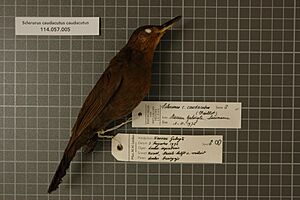Black-tailed leaftosser facts for kids
Quick facts for kids Black-tailed leaftosser |
|
|---|---|
 |
|
| Conservation status | |
| Scientific classification | |
| Genus: |
Sclerurus
|
| Species: |
caudacutus
|
 |
|
The black-tailed leaftosser (Sclerurus caudacutus) is a type of bird. It belongs to the ovenbird family called Furnariidae. This bird lives in several South American countries. You can find it in Bolivia, Brazil, Colombia, Ecuador, French Guiana, Guyana, Peru, Suriname, and Venezuela.
Contents
About This Bird
The black-tailed leaftosser is one of the darkest birds in its group. It is usually about 16 to 18 centimeters (6 to 7 inches) long. It weighs between 34 and 42 grams (1.2 to 1.5 ounces). Both male and female birds look very similar.
What It Looks Like
This bird has a dark reddish-brown face. Its head is dark brown. Its back and rump are also very dark reddish-brown. The tail is a sooty blackish color. Its wings are dark reddish-brown.
The throat of the black-tailed leaftosser is whitish. Its chest is dark reddish-brown. The rest of its belly is blackish-brown. It has brown eyes. Its bill is long and straight, mostly black. Its legs and feet are dark brown. Young birds are a bit darker than adults. They also have a smaller white area on their throat.
Where It Lives
The black-tailed leaftosser lives in lowland tropical evergreen forests. These are forests where trees stay green all year. It can be found from near sea level up to about 1,100 meters (3,600 feet) high. In some areas, it usually stays below 500 meters (1,600 feet).
How It Behaves
Staying in One Place
This bird does not migrate. It stays in the same area all year long.
What It Eats
The black-tailed leaftosser mostly looks for food on the ground. It flips aside leaves with its bill. It also probes the ground and picks up food from leaf litter. It usually hops around while searching. This bird often forages alone or in pairs.
Its diet includes many small creatures without backbones. These are called invertebrates. It eats things like cockroach eggs, beetles, and ants. It also eats annelid worms. Sometimes, it has been seen eating fallen fruit.
Raising Young
We don't know much about when these birds breed. In Peru, they breed in June. They build their nests in a burrow. This burrow is usually dug into an earthen bank. At the end of the burrow, there is a chamber. The birds line this chamber with leaves to make a cup-shaped nest.
They usually lay two eggs. Both parent birds help to feed the young birds.
Its Song and Calls
The song of the black-tailed leaftosser is a series of loud, clear notes. It sounds like "kweet" or "whee." There are usually 10 to 12 notes. The song goes down in pitch. It often starts with a low, sputtering sound. Its call is a sharp sound like "skweeup."
Its Protection Status
The IUCN (International Union for Conservation of Nature) has listed the black-tailed leaftosser as a species of Least Concern. This means it is not currently in danger of extinction. It lives in a very large area. However, its population size is not known. Experts believe its numbers might be going down.
No immediate threats to this bird have been found. It is considered uncommon to common in different parts of its range. It lives in several protected areas. This bird does not like forests that are broken up or where trees have been cut down.


